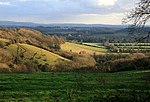Alton line

The Alton line is a railway line in Hampshire and Surrey, England, operated by South Western Railway as a relatively long branch of the South West Main Line. The branch leaves the main line at Pirbright Junction to the west of Brookwood station, Surrey, then turns to the southwest. The route crosses and recrosses the Surrey / Hampshire border, and serves the towns of Aldershot and Farnham before reaching its present-day terminus at Alton in East Hampshire. The line originally continued west to Winchester; the section between Alton and New Alresford is preserved as the heritage Watercress line. The Alton line was electrified (750 V DC third rail) during the late interwar years by Southern Railway. Aside from regular electric trains, freight trains operated by DB Cargo UK and steam trains connected to the Mid Hants Watercress Railway (by way of rolling stock supply or special excursion) operate on the line.
Excerpt from the Wikipedia article Alton line (License: CC BY-SA 3.0, Authors, Images).Alton line
Jordan Grove, East Hampshire
Geographical coordinates (GPS) Address Nearby Places Show on map
Geographical coordinates (GPS)
| Latitude | Longitude |
|---|---|
| N 51.165555555556 ° | E -0.96624444444444 ° |
Address
Jordan Grove
Jordan Grove
GU34 2FW East Hampshire
England, United Kingdom
Open on Google Maps



